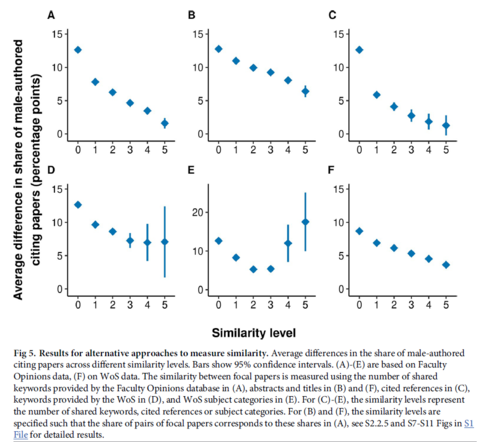New Publication by Alexander Tekles, Katrin Auspurg, and Lutz Bornmann concerning homophily bias in same-gender citations published in PLOS ONE
27.09.2022
Same-gender citations do not indicate a substantial gender homophily bias
Alexander Tekles, Katrin Auspurg, Lutz Bornmann (2022); PLOS ONE 17(9):
https://doi.org/10.1371/journal.pone.0274810
Can the male citation advantage (more citations for papers written by male than by female scientists) be explained by gender homophily bias, i.e., the preference of scientists to cite other scientists of the same gender?
Alexander Tekles, Katrin Auspurg, and Lutz Bornmann provide novel evidence on this highly debated mechanism (homophily bias) for persistent gender inequalities in science. Citation counts form the basis for popular performance indicators such as the h-index or journal impact factors for assessing the performance of individual researchers and research institutions. However, citations can only be used as valid performance indicators if they (mainly) reflect the quality of papers. When factors such as gender homophily bias play a role in citation decisions, research evaluations using citations would disadvantage female researchers.
The innovative element of the study is to show that gender homophily bias can only be correctly identified if citation counts are thoroughly adjusted for structural aspects such as the gender compositions of research fields (horizontal segregation). The authors apply and compare novel methods to identify similar research fields and topics. Using a large body of citation data on papers published in recent years spanning all research fields covered by the Web of Science (WoS), the authors find that there is little evidence of gender homophily bias once structural aspects are controlled for.

Further contributions of the study:
• The authors empirically show that previous research has not adequately identified and controlled for gender specific compositions of research fields and topics in science. This led to an over-estimation of observed gender-homophily bias.
• The authors compare methods to control for research fields based on the similarity between papers in terms of keywords, abstracts, etc. They show that research topics need to be controlled at a fine-grained level to identify homophily bias.
• Also a thorough control of general trends in science (such as the increasing representation of female scientists) is needed. To this end, the authors use the focal papers’ citing papers instead of their cited references, as other studies have done. This allowed for a better control of the publication year.
All in all, the study indicates that the role of structural aspects such as gender segregation in different research fields must be adequately reflected in both research and evaluations in order to better understand and mitigate gender inequalities. The study aims to serve as template for identifying research fields and identifying gender bias in science based on observational citation data, since it proposes novel research approaches. The use of adequate methodological approaches for empirical analyses of gender bias in science is particularly important since gender bias is an ongoing hot topic in science studies. Since many years, the topic has attracted much attention and has generated important policy implications.
Are you interested in doing similar research? Please have a look at our job advertisement (application deadline: 2022-11-02):
https://job-portal.lmu.de/jobposting/63e62780768cb2c58264f3efc9975c5ca59cb1e6

